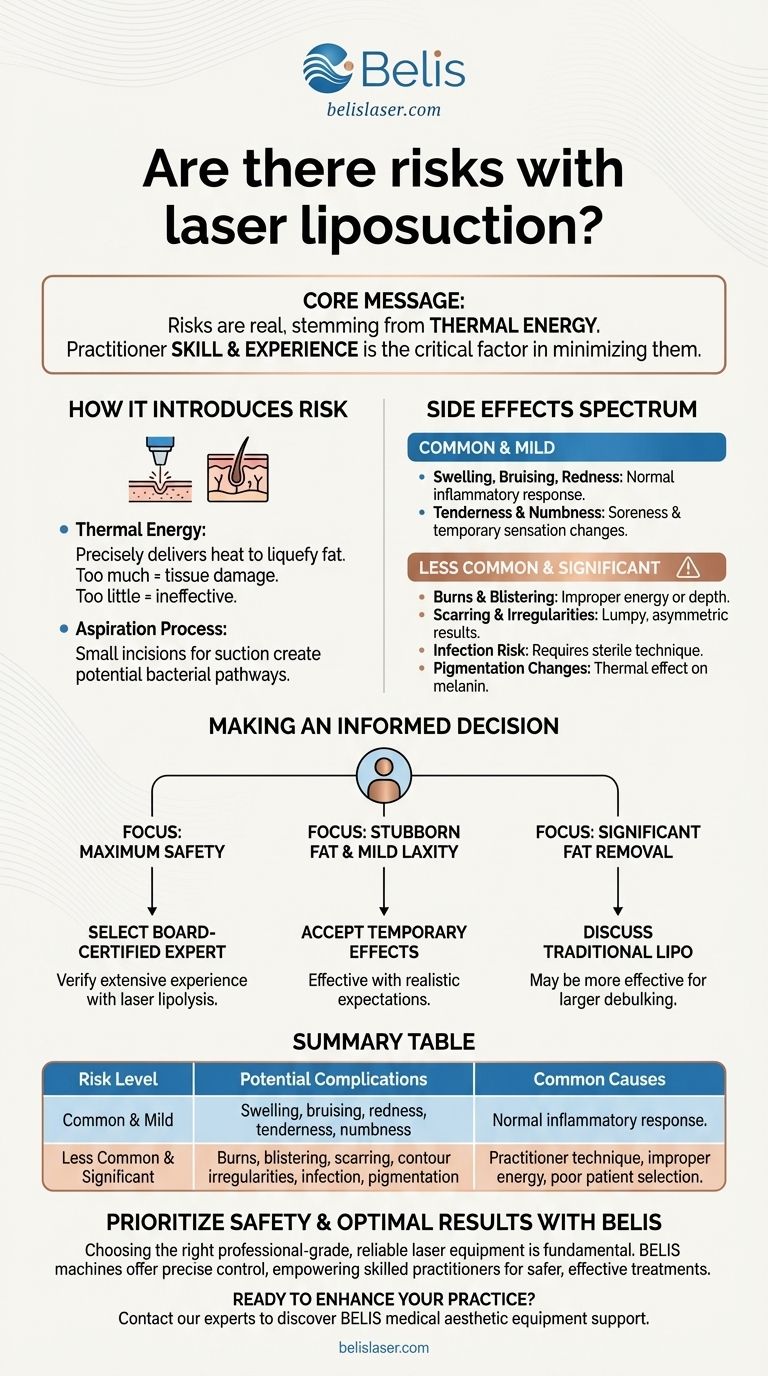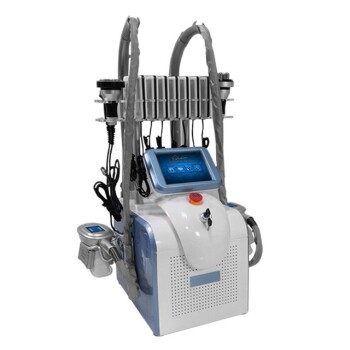Yes, there are risks associated with laser liposuction, although it is generally considered safe when performed by a qualified professional. The risks range from common, mild, and temporary side effects like swelling and redness to less common but more significant complications. The core of these risks is tied directly to the thermal energy the laser uses to liquefy fat.
The decision to undergo laser liposuction requires weighing its unique benefit—skin tightening—against the inherent risks of a thermal energy-based procedure. The single most important factor in minimizing these risks is not the technology itself, but the skill and experience of the practitioner operating it.

How the Procedure Introduces Risk
To understand the risks, you must first understand the mechanism. Laser liposuction, also known as laser lipolysis, uses a targeted laser fiber to heat and liquefy fat cells beneath the skin.
The Role of Thermal Energy
The procedure's effectiveness hinges on delivering a precise amount of thermal energy. This heat melts the fat, making it easier to remove, and also stimulates collagen production in the overlying skin.
However, this same heat is the primary source of potential complications. Too much energy can damage surrounding tissues, while too little can lead to ineffective results.
The Aspiration Process
In some cases, called laser-assisted liposuction, the liquefied fat is gently suctioned out through very small incisions. Any procedure that breaks the skin's surface introduces a pathway for bacteria.
Common and Mild Side Effects
These are the most frequent outcomes and typically resolve on their own as part of the natural healing process.
Swelling, Bruising, and Redness
This is the body's normal inflammatory response to the procedure. The insertion of the laser cannula and the heat generated cause temporary swelling and bruising in the treated area.
Tenderness and Numbness
The treated area will likely be sore, similar to a deep muscle ache. It is also common to experience temporary numbness or changes in skin sensation as the small nerves in the area recover from the heat and manipulation.
Understanding the More Significant Risks
While less common, it is critical to be aware of the more serious potential complications. These are almost always related to practitioner technique or improper patient selection.
Burns and Blistering
If the laser probe is held too close to the underside of the skin or if the energy level is too high, it can cause thermal burns. In severe cases, this can lead to blistering and permanent skin damage.
Scarring and Contour Irregularities
Uneven fat removal or improper healing can result in a lumpy, wavy, or asymmetric appearance. Scarring can also occur, either from burns or at the small incision sites.
Risk of Infection
As noted in the reference, any incision carries a risk of infection. While the incisions for laser lipo are tiny, they still require proper sterile technique and post-procedure care to prevent bacterial contamination.
Changes in Skin Pigmentation
The thermal energy can sometimes affect the melanin-producing cells in the skin. This can lead to hyperpigmentation (darkening) or hypopigmentation (lightening) of the skin in the treated area.
Making an Informed Decision
Your outcome is directly tied to the choices you make before the procedure ever begins.
- If your primary focus is maximum safety: Your non-negotiable first step is to select a board-certified dermatologist or plastic surgeon with extensive, demonstrable experience specifically with laser lipolysis.
- If your primary focus is addressing stubborn fat with mild skin laxity: This procedure can be highly effective, provided you accept the common, temporary side effects like swelling and have realistic expectations.
- If your primary goal is significant fat removal: You should discuss traditional liposuction with your surgeon, as it may be a more effective tool for debulking larger areas, though it is more invasive.
Ultimately, a successful outcome depends on a clear understanding of the full risk profile, not just the potential benefits.
Summary Table:
| Risk Level | Potential Complications | Common Causes |
|---|---|---|
| Common & Mild | Swelling, bruising, redness, tenderness, numbness | Normal inflammatory response to the procedure. |
| Less Common & Significant | Burns, blistering, scarring, contour irregularities, infection, skin pigmentation changes | Related to practitioner technique, improper energy levels, or poor patient selection. |
Prioritize Safety and Optimal Results with BELIS
Choosing the right equipment is fundamental to minimizing risks and achieving excellent outcomes in laser liposuction. BELIS specializes in providing medical aesthetics clinics and premium beauty salons with professional-grade, reliable laser liposuction machines. Our equipment is engineered for precise control and consistent performance, empowering skilled practitioners to deliver safer, more effective treatments.
Ready to enhance your practice's capabilities and patient safety?
Contact our experts today to discover how BELIS's professional medical aesthetic equipment can support your success.
Visual Guide

Related Products
- Q Switch Nd Yag Laser Machine Tattoo Removal Nd Yag Machine
- Cryolipolysis Fat Freezing Cavitation Lipo Laser Machine
- Cryolipolysis Fat Freezing Machine with Cavitation and Laser Lipolysis
- Clinic Use IPL and SHR Hair Removal Machine with Nd Yag Laser Tattoo Removal
- EMSlim RG Laser Body Sculpting and Slimming Machine
People Also Ask
- What is the mechanism of action of the YAG laser? Precision Cutting & Deep Tissue Coagulation
- What are the side effects of Q-switch laser? A Guide to Safe, Effective Treatment
- Is Q-Switch laser safe for skin? Achieve Precise, Non-Invasive Skin Rejuvenation Safely
- What are the disadvantages of Q-switch laser? Managing Risks for Safe Treatment
- What are the disadvantages of Q switching? Trade-offs in Pulse Control, Cost, and Beam Quality



















